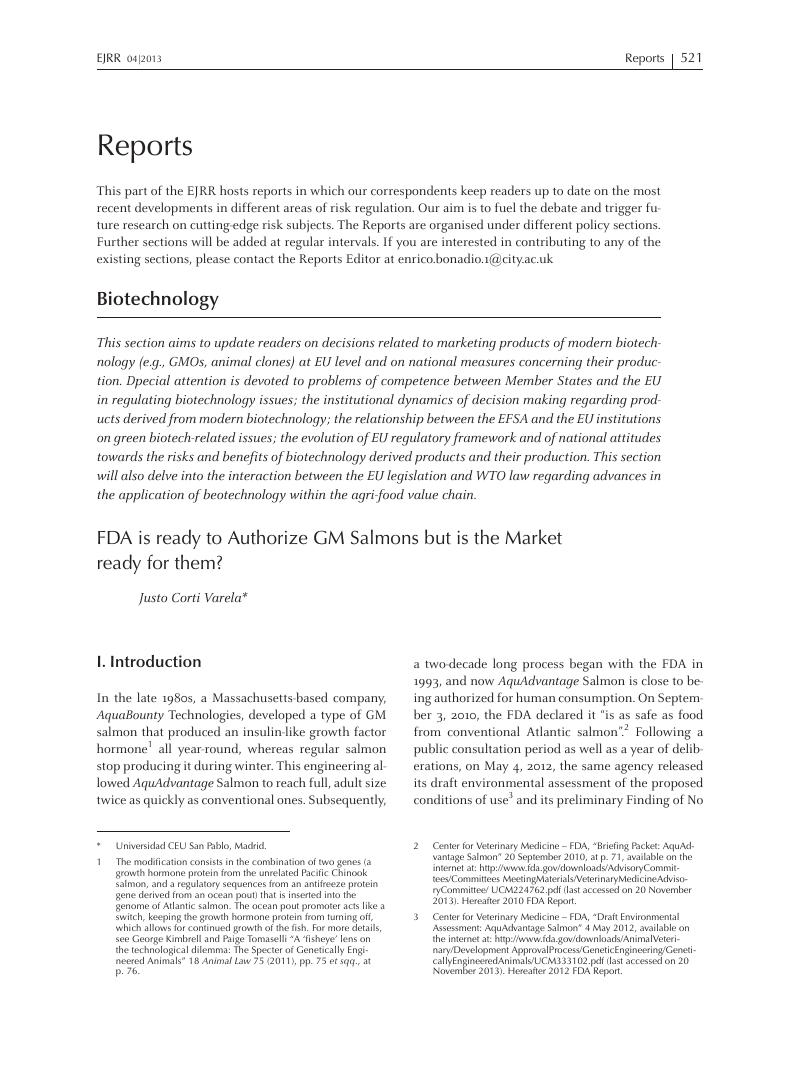Article contents
FDA is ready to Authorize GM Salmons but is the Market ready for them?
Published online by Cambridge University Press: 20 January 2017
Abstract

- Type
- Reports
- Information
- Copyright
- Copyright © Cambridge University Press 2013
References
1 The modification consists in the combination of two genes (a growth hormone protein from the unrelated Pacific Chinook salmon, and a regulatory sequences from an antifreeze protein gene derived from an ocean pout) that is inserted into the genome of Atlantic salmon. The ocean pout promoter acts like a switch, keeping the growth hormone protein from turning off, which allows for continued growth of the fish. For more details, see Kimbrell, George and Tomaselli, Paige “A ‘fisheye’ lens on the technological dilemma: The Specter of Genetically Engineered Animals” 18 Animal Law 75 (2011), pp. 75 et sqq., at p. 76Google Scholar.
2 Center for Veterinary Medicine – FDA, “Briefing Packet: AquAdvantage Salmon” 20 September 2010, at p. 71, available on the internet at: http://www.fda.gov/downloads/AdvisoryCommittees/CommitteesMeetingMaterials/VeterinaryMedicineAdvisoryCommittee/UCM224762.pdf (last accessed on 20 November 2013). Hereafter 2010 FDA Report.
3 Center for Veterinary Medicine – FDA, “Draft Environmental Assessment: AquAdvantage Salmon” 4 May 2012, available on the internet at: http://www.fda.gov/downloads/AnimalVeterinary/DevelopmentApprovalProcess/GeneticEngineering/GeneticallyEngineeredAnimals/UCM333102.pdf (last accessed on 20 November 2013). Hereafter 2012 FDA Report.
4 Center for Veterinary Medicine – FDA, “Preliminary Finding of No Significant Impact: AquAdvantage Salmon” 4 May 2012, available on the internet at: http://www.fda.gov/downloads/AnimalVeterinary/DevelopmentApprovalProcess/GeneticEngineering/GeneticallyEngineeredAnimals/UCM333105.pdf (last accessed on 20 November 2013). Hereafter FONSI.
5 The GloFish is the only GM animal available for purchase commercially, although it has never been approved for commercial use. See Bratspies, Rebecca M., “Glowing in the Dark: How America’s First Transgenic Animal Escaped Regulation”, 6 Minnesota Journal of Law, Science & Technology (2005), p. 457, et sqq., at p. 475–77Google Scholar.
6 Vàzquez-Salat, Núria, Salter, Brian, Smets, Greet, Houdebine, Louis-Marie “The current state of GMO governance: Are we ready for GM animals?” 30 Biotechnology Advances (2012) pp. 1336 et sqq., at pp. 1337CrossRefGoogle ScholarPubMed.
7 For example, the ATryn, an anticoagulant derived from the milk of GM goats used for the prevention of blood clots in patients with hereditary antithrombin (AT) deficiency. Concerning the between pharmaceutical use and human consumption, see Sheryl Lawrence, “What Would You Do with a Fluorescent Green Pig?: How Novel Transgenic Products Reveal Flaws in the Foundational Assumptions for the Regulation of Biotechnology”, 34 Ecology Law Quarterly (2007) pp. 201 et sqq., at pp. 256–59.
8 Transplantation of cell, tissue or organs from one species to another. Due to their evolutionary closeness with humans, pigs are the most common species expected to be used for these types of applications.
9 For example, the “Enviropig,” a pig engineered to better digest phosphates, making it more environmentally friendly; dairy cows resistant to mastitis, cows resistant to bovine spongiform encephalopathy; or chickens resistant to avian flu.
10 Curieux-Belfond, Olivier Le, Vandelac, Louise, Seralini, Joseph Caron Gilles-Eric “Factors to consider before production and commercialization of aquatic genetically modified organisms: the case of transgenic salmon” 12 Environmental Science & Policy (2009), pp. 170 et sqq., at p. 174CrossRefGoogle Scholar. These authors give several examples of possible risks of transgenesis in fishes.
11 Supra note 2, at p. 116.
12 Ibid., at p. 115.
13 For each kilogram of farmed salmon between 1.2 and 1.4 kilograms of dry pellets are needed, i.e. 4 or 5 kilograms of cached fresh fish.
14 These steps are: (1) Product Definition, (2) Molecular Characterization of the Construct, (3) Molecular Characterization of the GE Animal, (4) Phenotypic Characterization of the GE Animal, (5) Durability: Genotypic and Phenotypic Plan, (6) Food/Feed/Environmental Safety, and (7) Claim Validation.
15 Supra, note 6 at p. 1339.
16 Office of Science and Technology Policy – Office of the President of the US “Coordinated Framework for Regulation of Biotechnology”, 51 Fed. Reg. 23,302 (26 June 1986), available on the internet at: http://www.aphis.usda.gov/brs/fedregister/coordinated_framework.pdfhttp://www.aphis.usda.gov/brs/fedregister/coordinated_framework.pdf (last accessed on 20 November 2013).
17 Center for Veterinary Medicine – FDA, “Guidance for Industry: Regulation of Genetically Engineered Animals Containing Heritable Recombinant Constructs” 15 January 2009 (revised on 17 May 2011).
18 US Federal Food, Drug, and Cosmetic Act, 21 U.S.C. § 321(v).
19 Supra note 17, at p. 6.
20 Supra note 18, at § 321(v).
21 George Kimbrell and Paige Tomaselli, supra note 1.
22 Supra note 18, at § 321(u).
23 See, for example, the letter signed by 29 U.S. Representatives demanding the FDA “stop the approval process immediately” because potential human health and environmental risks have not been adequately reviewed. Letter from Peter DeFazio, U.S. Representative, et al., to Margaret A. Hamburg, FDA Commissioner, 29 September 2010, available on the internet at: http://www.defazio.house.gov/index.php?option=com_content&task=view&id=629 (last accessed on 20 November 2013).
24 Office of Science and Technology Policy – Office of the President of the US “Case Study n° 1: Growth-Enhanced Salmon” (2001), available on the internet at: http://www.whitehouse.gov/galleries/Issues/ceq_ostp_study2.pdf (last accessed on 20 November 2013)
25 Homer, Michael Bennett “Frankenfish … It's What's for Dinner: The FDA, Genetically Engineered Salmon, and the Flawed Regulation of Biotechnology” 45 Columbia Journal of Law and Social Problems (2012), pp. 83 et sqq. at p. 105Google Scholar.
26 Supra note 2, at p. 71.
27 Paul Voosen, “Panel Advises More Aggressive FDA Analysis of Engineered Salmon, New York Times, 21 September 2010, available on the internet at: http://www.nytimes.com/gwire/2010/09/21/21greenwire-panel-advises-moreaggressive-fda-analysis-of-71171.html?pagewanted=all (last accessed on 20 November 2013).
28 Supra note 3, at 54.
29 Supra note 3, at p. 15.
30 Supra note 6, at p. 1337.
31 McEvilly, Michael P. “Lack of Transparency in the premarket approval process for Aquadvantage Salmon” 11 Duke Law & Technology Review (2013), pp. 413 et sqq Google Scholar.
- 1
- Cited by




